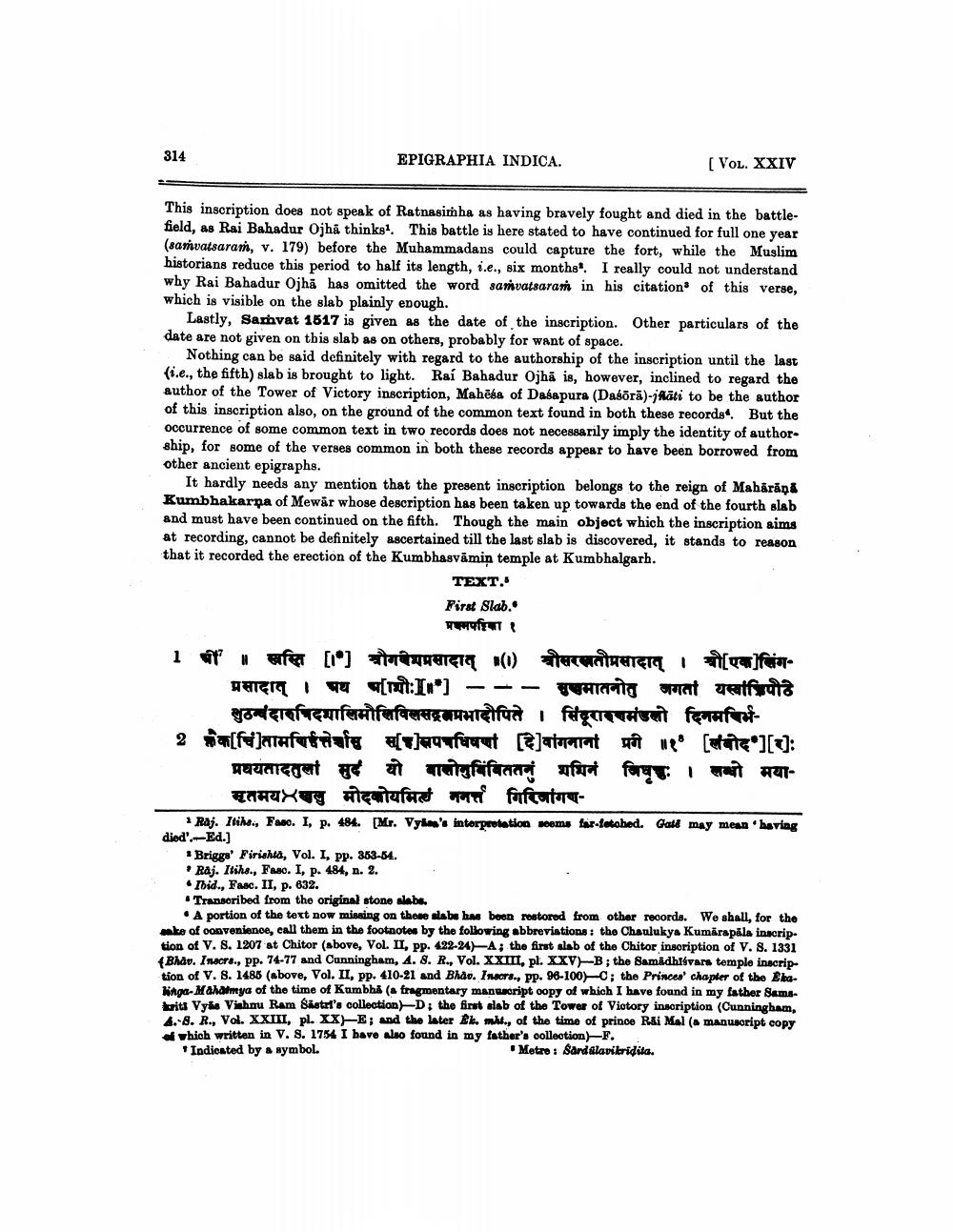________________
314
EPIGRAPHIA INDICA.
[Vol. XXIV
This inscription does not speak of Ratnasimha as having bravely fought and died in the battlefield, as Rai Bahadur Ojhã thinks. This battle is here stated to have continued for full one year (samvatsaram, v. 179) before the Muhammadans could capture the fort, while the Muslim historians reduce this period to half its length, i.e., six months!. I really could not understand why Rai Bahadur Ojha has omitted the word samvatsaran in his citation of this verse, which is visible on the slab plainly enough.
Lastly, Samvat 1517 is given as the date of the inscription. Other particulars of the date are not given on this slab as on others, probably for want of space.
Nothing can be said definitely with regard to the authorship of the inscription until the last (i.e., the fifth) slab is brought to light. Rai Bahadur Ojha is, however, inclined to regard the author of the Tower of Victory inscription, Mahēsa of Dasapura (Dasörä)-j Aläti to be the author of this inscription also, on the ground of the common text found in both these records. But the occurrence of some common text in two records does not necessarily imply the identity of author ship, for some of the verses common in both these records appear to have been borrowed from other ancient epigraphs.
It hardly needs any mention that the present inscription belongs to the reign of Maharāņa Kumbhakarpa of Mewar whose description has been taken up towards the end of the fourth slab and must have been continued on the fifth. Though the main object which the inscription aims at recording, cannot be definitely ascertained till the last slab is discovered, it stands to reason that it recorded the erection of the Kumbhagvåmin temple at Kumbhalgarh.
TEXT. First Slab.
प्रथमपरिवा। 1 st afer [i) toneretą (1) Hecenthalera (va]fetare
SHER I actuit:Ix") --- WCHATO pat velfuta
सुठवंदारदिशालिमौसिविलसद्रसप्रभादौपिते । सिंदूरारक्षमंडलो दिनमविर्भ2 wa[f]atafofuate lauwwet [E]aturacat q ue [state'][1]:
प्रथयतादतुला मुद यो बासोनुबिंबिततर्नु थपिनं जिवृतः । लब्बो मया
सतमया खलु मोदकोयमिदं ननत गिरिजांगणRaj. Itihe., Faso. I, p. 484. [Mr. Vylie's interpretation soems far-fetched. Gald may mean'having diod'.-Ed.)
* Briggs' Firishta, Vol. I, pp. 353-54. . Raj. Itihs., Faso. I, p. 484, n. 2. • Ibid., Fasc. II, p. 632. . Transcribed from the original stone slabe
• A portion of the tott now missing on these slabe has been restored from other records. We shall, for the wake of convenience, call them in the footnotes by the following abbreviations: the Chaulukya Kumarapala inscrip. tion of V. S. 1207 at Chitor (above, Vol. II, pp. 422-24-A; the first slab of the Chitor inscription of V. 8. 1331 4 Bhau. Inacre., pp. 74-77 and Cunningham, 4. 8. R., Vol. XXI, pl. XXV) B; the Samadhisvar temple inscription of V. 8. 1485 (above, Vol. II, pp. 410-21 and Bhão. Inacra., pp. 98-100) ; the Princes' chapter of the ElbaKinga-Mahatmya of the time of Kumbhi (a fragmentary manuscript oopy of which I have found in my father Sams
pits Vyks Vishnu Ram Bhatrt's collection) D: the first slab of the Tower of Victory inacription (Cunningham, 4.-8. R., Vol. XXIII, pl. XX-E; and the later El, wht, of the time of prince R&i Mal (a manuscript copy Which written in V. S. 1754 I have also found in my father's collection) F. * Indicated by a symbol.
Metre : Sardilapikridita.




